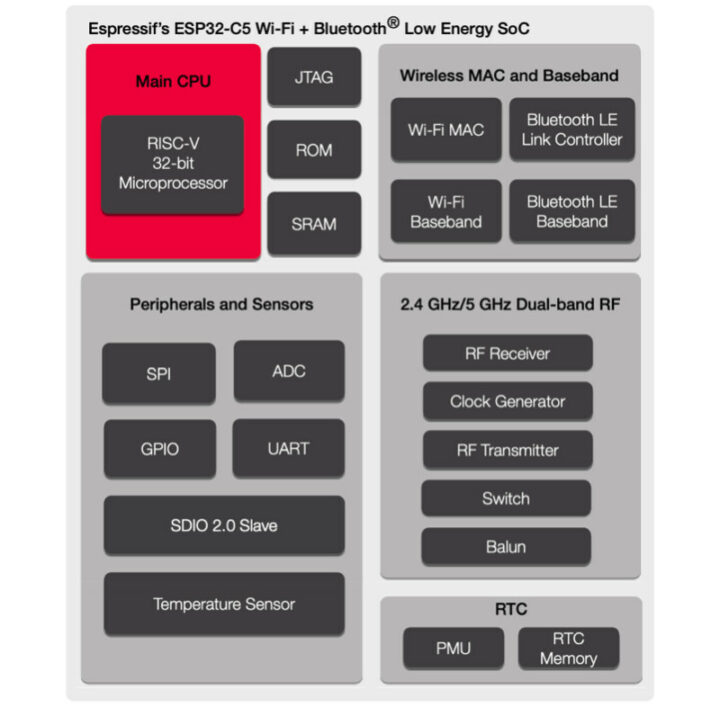Espressif Systems ESP32-C5 is an upcoming wireless RISC-V microcontroller for IoT applications that supports dual-band (2.4 & 5.0 GHz) WiFi 6 connectivity as well as Bluetooth 5.0 LE.
It is the first dual-band processor from Espressif, as while the Shanghai-based company previously announced the ESP32-C6 WiFi 6 and Bluetooth 5 LE RISC-V SoC last year, it only supports 2.4 GHz frequency. Note it’s not the first dual-band WiFi 6 IoT chip on the market as NXP introduced the IW612 Wi-Fi 6, Bluetooth 5.2, 802.15.4 tri-radio solution last January, but ESP32-C5 should target different use cases.
ESP32-C5 preliminary specifications:
- CPU – Single-core 32-bit RISC-V processor @ up to 240 MHz
- Memory – 400KB SRAM on-chip
- Storage – 384KB of ROM on-chip, support for external flash
- Connectivity
- Dual-band 802.11ax WiFi 6 in the 2.4GHz and 5 GHz bands, with 802.11b/g/n WiFi 4 standard support for backward compatibility
- 20MHz bandwidth for the 802.11ax mode
- 20/40MHz bandwidth for the 802.11b/g/n mode
- OFDMA (Orthogonal Frequency Division Multiple Access) mechanism for both uplink and downlink
- MU-MIMO capability for downlink
- Target Wake Time (TWT) support allows devices to sleep for an extended time-period (important for battery life)
- Bluetooth 5.0 Low Energy (LE )
- Dual-band 802.11ax WiFi 6 in the 2.4GHz and 5 GHz bands, with 802.11b/g/n WiFi 4 standard support for backward compatibility
- I/Os
- Over 20 programmable GPIOs
- SPI, UART, ADC
- SDIO 2.0 Slave interface
- Misc – Temperature sensor, RTC
Support for 5 GHz WiFi provides several benefits to IoT devices. First OFDMA and MU-MIMO enable higher efficiency and low latency in congested wireless environments, while also improving connectivity in high-density environments. Then TWT support will allow the development of battery-operated ESP32-C5 devices that can last for years on a single charge. Finally, the higher throughput (no PHY rate numbers provided yet) will enable new applications such as live-streaming devices, Wi-Fi dongles, IP cameras, etc…
Espressif will offer continuity in terms of software as the ESP32-C5 WiSoC will be supported by the same Espressif’s open-source FreeRTOS-based ESP-IDF used by other ESP32 and ESP8266 devices. It will also be possible to use the ESP32-C5 as a wireless co-processor with an external host through either the ESP-AT (AT command set) or ESP-Hosted (802.11 interface for Linux hosts) SDKs.
The company does not provide availability information for the new dual-band chip in the press release but invites interested companies to contact them.

Jean-Luc started CNX Software in 2010 as a part-time endeavor, before quitting his job as a software engineering manager, and starting to write daily news, and reviews full time later in 2011.
Support CNX Software! Donate via cryptocurrencies, become a Patron on Patreon, or purchase goods on Amazon or Aliexpress





